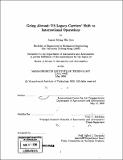| dc.contributor.advisor | Peter P. Belobaba. | en_US |
| dc.contributor.author | Lee, James Shing Hin | en_US |
| dc.contributor.other | Massachusetts Institute of Technology. Dept. of Aeronautics and Astronautics. | en_US |
| dc.date.accessioned | 2009-04-29T17:13:15Z | |
| dc.date.available | 2009-04-29T17:13:15Z | |
| dc.date.copyright | 2008 | en_US |
| dc.date.issued | 2008 | en_US |
| dc.identifier.uri | http://hdl.handle.net/1721.1/45238 | |
| dc.description | Thesis (S.M.)--Massachusetts Institute of Technology, Dept. of Aeronautics and Astronautics, 2008. | en_US |
| dc.description | Includes bibliographical references (p. 115-117). | en_US |
| dc.description.abstract | In the recent few years, there has been an observed trend of US legacy carriers putting more emphasis on international traffic than domestic, i.e. expanding international capacity while decreasing their domestic capacity. It is generally understood that the reason for doing so is due to the lower level of competition in international markets. Compared with the highly deregulated domestic market, legacy carriers face less competition in international markets especially from low cost carriers, and thus should be able to generate a higher yield. The goal of this thesis is to examine how the operational strategies for legacy carriers have changed and how different factors affected the changes. More specifically, the evolution of operations of legacy carriers in different regions of the world from 1995 to 2006 was analyzed in order to understand quantitatively how these strategies evolved through time, the driving force behind the change, and the results of the changes. We looked at the relative traffic and capacity volumes in different regions, and compared the costs, revenues and profitability among them. This study showed that between 2003 and 2006, legacy carriers increased international capacity by 26% while decreasing domestic capacity by 5%, thereby increasing their proportion of international capacity from 30% to 36%. Two measures were found to be a good explanatory variable for this shift. This first was the relative change of profitability between domestic and international operations as derived from the change in gap between domestic and international unit cost (Ex Transport Related & Fuel) and the change in gap between domestic and international passenger unit revenue between 2000 and 2003, whereby the international profitability improved relative to domestic profitability in the period. | en_US |
| dc.description.abstract | (cont.) The other was the yield premium that international operations have over domestic markets after average stage length was adjusted for. Both of these factors created the setting for US legacy carriers to aggressively shift operations internationally. | en_US |
| dc.description.statementofresponsibility | by James Shing Hin Lee. | en_US |
| dc.format.extent | 117 p. | en_US |
| dc.language.iso | eng | en_US |
| dc.publisher | Massachusetts Institute of Technology | en_US |
| dc.rights | M.I.T. theses are protected by
copyright. They may be viewed from this source for any purpose, but
reproduction or distribution in any format is prohibited without written
permission. See provided URL for inquiries about permission. | en_US |
| dc.rights.uri | http://dspace.mit.edu/handle/1721.1/7582 | en_US |
| dc.subject | Aeronautics and Astronautics. | en_US |
| dc.title | Going abroad : US legacy carriers' shift to international operations | en_US |
| dc.title.alternative | US legacy carriers' shift to international operations | en_US |
| dc.type | Thesis | en_US |
| dc.description.degree | S.M. | en_US |
| dc.contributor.department | Massachusetts Institute of Technology. Department of Aeronautics and Astronautics | |
| dc.identifier.oclc | 309336992 | en_US |
